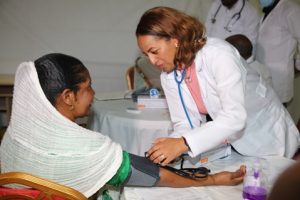I n Ethiopia now around half of death is caused by Non Communicable Diseases (NCDs) even more than that of communicable ones says Professor Abraham Haileamlak Human Resource Directorate and Advisor at Ethiopian Health Care. He adds that NCDs are at the alarming stage due to lack of awareness and misconception about the magnitude of the problem here in Ethiopia. This is due to lack of awareness of the society and misconception about the problem.
Despite the large burden of disease approximately half of morbidity and mortality and economic impact comprised by NCDIs, the National Health Account demonstrates that only the total health expenditure allocated to NCD is low. NCDs namely cancer, cardiovascular disease, chronic respiratory disease and diabetic account for 60 percent of all global deaths. According to NCD alliance, 80 percent of deaths caused by NCDs occur in developing countries.
He pointed out that, maintaining a healthy weight, adopting physically active lifestyle, stopping tobacco use, avoiding smoke and limiting alcohol consumption will be the solution for the problems. Professor Abraham further urged the public to maintain healthy diet with an emphasis on plant source such as fruit, vegetables and grain. As a way forward he said that, the government, media, Ethiopian health care and the concerned stakeholders must cooperate to eliminate the problem and make conducive environment for the wide society.
Ethiopia is one of the fast-growing economies in Africa with a vision to reach a middle-income status by 2035. Realization of this vision will require a healthy and productive population. Improving the health status of the population is among the key priorities of the Government of Ethiopia. As a result of its robust health policy and innovative strategies, the country has made huge steps in increasing universal access to health services through rapid expansion of primary health care that resulted in impressive gains in health status of the population.
Most of these health gains are related to achievements in communicable, maternal, childhood and nutritional disorders. Despite substantial strides made in improving population health status in Ethiopia, still a lot is required in creating a health system that can withstand all adversities. Ethiopia is still one of the countries with a very high morbidity and mortality from triple burden of diseases consisting of Communicable, maternal, nutritional diseases Non-communicable diseases, mental, neurological and substance use disorders and Injuries.
According to 2016 estimates, noncommunicable diseases and injuries represented 46 percent of the total disease burden in Ethiopia, which is expected to rise rapidly in the coming decades along with economic development, urbanization and life style changes. There are ongoing efforts to curtail the epidemic of noncommunicable diseases and injuries (NCDI) in the country but the magnitude of the problem calls for a multi-sectoral mechanism and a considerable increase in our effort to control and avert these conditions.
Speaking to The Ethiopian Herald, Officer of Non Communicable Diseases (NCDs) at Ethiopian Health Care Afendi Ousman said that NCDs and Injuries are major public health problems in Ethiopia, particularly affecting children, women, the population’s productive age group, the poor, and the underprivileged. Approximately half of all deaths and disability are now attributable to NCDs in Ethiopia.The proportion of deaths due to NCDs is roughly similar in both urban and rural settings.NCDIs in Ethiopia tend to occur at younger age, he elaborated.
Most of the NCDI disease burden cannot be attributed to individual lifestyle choices. Global Burden of Disease (GBD) 2016 review showed only 34 percent of NCDs disease burden Disability Adjusted Life Styles (DALYs) were attributable to identifiable risk factors in Ethiopia. Afendi further stated that risk factors such as tobacco, alcohol, and Khat use are on the rise in Ethiopia, and may lead to a substantial portion of NCDs.
While the overall rate of obesity is low in Ethiopia, it is over six times higher in the wealthiest quintile as compared to other socioeconomic groups. He pointed out that hypertension, low physical activity, raised total cholesterol, and high fasting plasma glucose were also associated with wealthier socioeconomic groups. The environmental risk factor of indoor air pollution was the second most important risk factor, and was more prevalent in rural populations.
In order to overcome the problem the ministry, media, concerning stakeholders and the public at large must discharge its responsibility and do its level best in terms of creating awareness on NCDs in collaboration with the public, concerning stakeholders and government Afendi noted. He stressed that, fast urbanization, the change of living style and eating and others are main causes for the NCDs in Ethiopia. As to him, citizens need to do physical exercise, eat a nutrient food and avoid alcoholic beverages to prevent NCDs.
The existence of NCDs has reached on the alarming stage in Ethiopia especially in urban areas recently. As a way forward establishing a national multi-sectoral committee on NCDs chaired by higher officials to guide and organize NCDs prevention and control is necessary, he said Moreover, multi-sectoral steering committees need also to be established at all levels of the government apart from implementing public health policies for NCDs prevention and control through comprehensive legislation and enforcement of national laws and regulations. He called on the government to allocate an increased percentage of gains from economic growth to health, move governmental spending on health rapidly, mobilize additional resources and the like.
The Ethiopian Herald April 27/2019
BY HAILE DEMEKE




